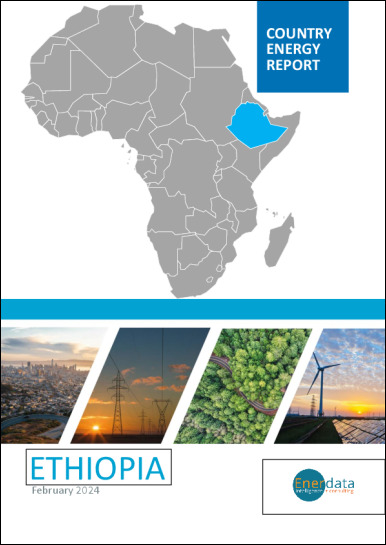- Update
-
- Format
- 3 files (PDF report, 2 Excel files)
- Pages
-
27 (Report only)
- Delivery
- Immediate by e-mail
- GENERAL OVERVIEW
- INSTITUTIONS AND ENERGY POLICY
- ENERGY COMPANIES
- ENERGY SUPPLY
- ENERGY PRICES
- ENERGY CONSUMPTION
- ISSUES AND PROSPECTS
- DATA TABLES
- ABBREVIATIONS
- GLOSSARY
Buy Ethiopia energy report
Price without VAT. Depending on your statute and location, VAT might be applicable. Get in touch with us for more information.
After validation, you will immediately receive 3 files by email (one pdf report and 2 excel files containing the datasets).
Overview
This analysis includes a comprehensive Ethiopia energy market report and updated datasets. It is derived from the most recent key economic indicators, supply and demand factors, oil and gas pricing trends and major energy issues and developments surrounding the energy industry. The report provides a complete picture of the country situation, dynamics, current issues and future prospects. With market data and continuous follow-up of markets news, this report brings clear and concise insights with which to tackle national energy challenges and opportunities. Browse the tabs below for a detailed table of contents, the list of graphs and tables, and details on the data files.
Highlights
- Total electrification of households has been postponed from 2025 to 2030 (51% in 2020).
- The electricity sector is dominated by public companies, while the hydrocarbon sector is managed by foreign companies.
- The power capacity has tripled since 2010, reaching 5.6 GW in 2023.
- Power production is dominated by hydropower (97%).
- Gasoline and diesel prices are regulated, and the government is seeking to cut subsidies.
- Electricity prices declined slightly in 2022 and 2023 and are among the lowest in the world.
- Despite rapid growth in electricity consumption, per capita consumption is still low (slightly above 100 kWh).
- Total energy consumption is mainly supplied with biomass (89%).
- The full commissioning of the large Grand Renaissance hydropower plant (5.15 GW) is delayed by negotiations with Egypt and Sudan and is expected in 2025.
Institutions & Energy Policy
The Ministry of Water and Energy (MoWE) is in charge of the development of energy policies, strategies, and programmes outside the oil sector.
The Ministry of Mines and Petroleum supervises the mineral and petroleum policies and promotes the country's oil potential.
Energy Companies
Electricity:
EEP ensures most of the electricity production with a capacity of 5.27 GW (94% of the total). There are 22 connected generation plants, mainly hydropower (16) and wind farms (4). In addition, EEP also has power plants using solid waste and geothermal sources (50 MW).
The most important IPP is Hydrochina, with its Adama wind parks (204 MW).
Energy Supply
Oil:
Since the closure of the Assab refinery in 1997, the country has imported all its oil requirements (about 4.6 Mt in 2023).
Energy Prices
Electricity:
Electricity prices increased between 2018 and 2020, as part of EEU's plans to make more attractive investments in power projects and then decreased slightly in 2022 and 2023 to US$2.2c/kWh for industrial customers and US$1.4c/kWh for households. They are among the lowest in the world (nearly 6.6 times lower than in Kenya for industry and almost 14 times lower for households).
Energy Consumption
In 2023, total energy consumption per capita is around 0.40 toe, including 106 kWh for electricity.
Issues & Prospects
Electricity:
Ethiopia strives to become an African power hub. The 17 GW capacity target in 2020 set in the 25-year Power System Expansion Master Plan of 2016 was far from being reached, with only5.6 GW in 2023. The National Power System Expansion Master Plan (2021) did not fix quantitative objectives.
- GRAPH 1: CO2-energy emissions (MtCO2)
- GRAPH 2: Installed electric capacity by source (2023, %)
- GRAPH 3: Gross power production by source (TWh)
- GRAPH 4: Power generation by source (2023, %)
- GRAPH 5: Gasoline & diesel prices (US$/l)
- GRAPH 6: Electricity prices for industry and households (US$c/kWh)
- GRAPH 7: Consumption trends by energy source (Mtoe)
- GRAPH 8: Total consumption market share by energy (2023, %)
- GRAPH 9: Final consumption market share by sector (2023, %)
- Economic Indicators: Annual historical data including population, GDP growth, imports and exports, inflation rate, energy security and efficiency indicators, CO2 emissions.
- Supply Indicators: Historical data including oil and gas reserves, electric and refining capacity, energy production, power production and external trade. All are detailed by energy source.
- Demand Indicators: Historical data including consumption per inhabitant, consumption trends, total consumption by energy source, final consumption by energy source and sector, and electricity consumption by sector.
- Energy Balances: Single table displaying the overall energy industry balance per annum, also graphically displayed by energy sub-segment.
- Infrastructure Projects: Covers power plant projects by energy, technology, status and operator.
The Ethiopia energy market data since 1990 and up to
is included in the Excel file accompanying the Ethiopia country report.
It showcases the historical evolution, allowing users to easily work with the data.
Key Data included in the excelsheet:
- Economic indicators: Annual historical economic indicators, energy security, energy efficiency and CO2 emissions.
- Supply indicators: Annual historical reserves, capacity, production and external trade (imports(+) exports(-) balance).
- Demand indicators: Annual historical consumption per capita, consumption trends, total consumption, final consumption (per energy and per sector) and electricity consumption total and per sector.
- Energy Balance: total and per energy.
- Ethiopia Energy Prices: In addition to the analysis provided on the report we also provided a data set which includes historical details on the Ethiopia energy prices for the follow items: price of premium gasoline (taxes incl.), price of diesel (taxes incl.), price of electricity in industry (taxes incl.), price of electricity for households (taxes incl.), price of natural gas in industry (taxes incl.), prices of natural gas for households (taxes incl.), spot price of Brent and CO2 emissions (from fuel combustion).
 Energy and Climate Databases
Energy and Climate Databases Market Analysis
Market Analysis